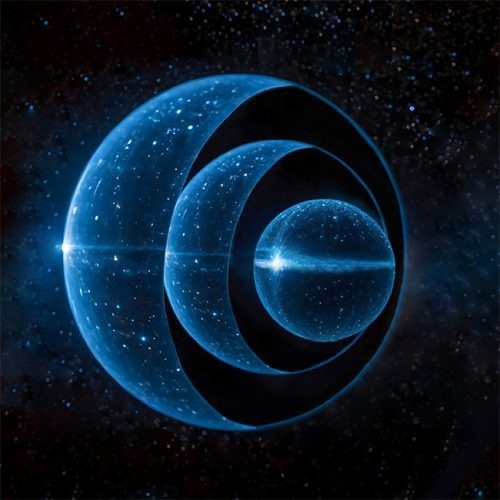Feb 16 2024Reviewed by Alexandra Corner
If gravitational condensate stars (or gravastars) existed, they would look similar to black holes to a distant observer.
Two theoretical physicists at Goethe University Frankfurt have now found a new solution to Albert Einstein’s theory of general relativity, according to which gravitational stars could be structured like a Russian matryoshka doll, with one gravastar located inside another.
 According to findings by physicists at Goethe University Frankfurt, a gravastar could look like a matryoshka doll. Image Credit: Daniel Jampolski and Luciano Rezzolla, Goethe University Frankfurt
According to findings by physicists at Goethe University Frankfurt, a gravastar could look like a matryoshka doll. Image Credit: Daniel Jampolski and Luciano Rezzolla, Goethe University Frankfurt
Science still cannot explain what is inside black holes. German physicist Karl Schwarzschild proposed a 1916 solution to Albert Einstein's general relativity equations, which states that a black hole's center is made up of a point known as the singularity, where space and time cease to exist.
According to this theory, the concept of causality is suspended, and all physical laws, including Einstein’s general theory of relativity, are rendered inapplicable. Since no information can escape from a black hole beyond the so-called event horizon, this is a significant annoyance to science.
This could explain the lack of interest in Schwarzschild’s solution outside of theoretical realms for a considerable amount of time, until the discovery of the first black hole candidate in 1971, the black hole at the center of the Milky Way in the 2000s, and eventually, the first black hole image obtained by the Event Horizon Telescope Collaboration.
Gravitational condensate stars, or gravastars, are objects Pawel Mazur and Emil Mottola put forth in 2001 as an alternative solution to Einstein's field equations. From a theoretical astrophysics point of view, gravastars have several advantages over black holes. They resemble black holes for all intents and purposes—they are nearly as compact as black holes and exhibit a gravity at their surface that is almost as strong as that of black holes.
However, the core of gravastars lacks a singularity and an event horizon—that is, a boundary that allows no information to be transmitted. Instead, the unusual, dark energy that makes up the center of a gravastar presses against the massive gravitational force that is compressing the star. Gravastar surfaces are modeled as wafer-thin layers of ordinary matter with a thickness close to zero.
Daniel Jampolski and Prof. Luciano Rezzolla, two theoretical physicists from Goethe University Frankfurt, have now proposed a solution to the general relativity field equations that characterize the existence of a gravastar inside another gravastar. They have called this hypothetical celestial object “nestar.”
Daniel Jampolski, who uncovered this solution as part of his Bachelor’s thesis under the supervision of Luciano Rezzolla, remarked, “The nestar is like a matryoshka doll,” adding that “our solution to the field equations allows for a whole series of nested gravastars. Whereas Mazur and Mottola posit that the gravastar has a near-infinite thin skin consisting of normal matter, the nestar’s matter-composed shell is somewhat thicker. It’s a little easier to imagine that something like this could exist.”
It’s great that even 100 years after Schwarzschild presented his first solution to Einstein’s field equations from the general theory of relativity, it’s still possible to find new solutions. It’s a bit like finding a gold coin along a path that has been explored by many others before. Unfortunately, we still have no idea how such a gravastar could be created. But even if nestars don’t exist, exploring the mathematical properties of these solutions ultimately helps us to better understand black holes.
Luciano Rezzolla, Professor, Theoretical Astrophysics, Goethe University
Journal Reference:
Jampolski, D. & Rezzolla, L. (2024) Nested solutions of gravitational condensate stars. Classical and Quantum Gravity. doi.org/10.1088/1361-6382/ad2317.
Source: https://www.goethe-university-frankfurt.de/en?locale=en